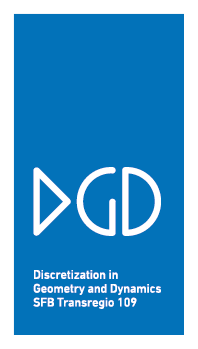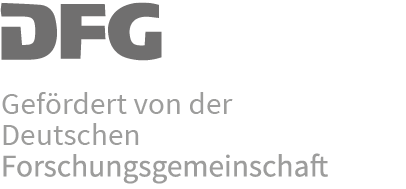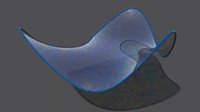Discrete S-Conical Catenoid and Helicoid
Alexander I. Bobenko, Tim Hoffmann, Benno König, Stefan SechelmannMedia
Description
We show the discrete s-conical catenoid and helicoid, constructed in [1]. The general construction method for s-conical minimal surfaces is as follows. First construct an orthogonal circle pattern on the sphere with the combinatorics of the curvature line pattern on the surface. The dual graph of the circle pattern is the discrete Gauss map of the corresponding minimal surface. Its vertices are the polar points of the circles of the pattern with respect to the sphere. The resulting polyhedron has faces tangent to the sphere and has the Koenigs property. For meshes with the Koenigs property we can calculate a dual mesh. This dual is the minimal surface with the prescribed combinatorics of curvature lines.
For the s-conical helicoid we can explicitly construct the corresponding circle pattern in the sphere. It is the S-Exp pattern [2], a discretization of the exponential map. The underlying quad-graph is $\mathbb Z^2$, with circles corresponding to points $(m, n)$ with $m + n \equiv 0 \mod 2$. The centers $c(m, n)$ and the radii $r(n,m)$ of the circles are \[c(n,m) = e^{\alpha n+i\rho m}, \quad r(n,m) = \sin(\rho) \left | c(n,m) \right |,\] where \[\rho = \pi/N, \quad \alpha = \mathrm{arctanh} (\frac{1}{2}\left |1 - e^{2i\rho} \right | ).\] We normalize the circle pattern such that the center of mass of the circle intersections is the center of the sphere. This can be achieved by a Moebius transformation of the sphere, see [3]. The corresponding s-conical minimal surface is shown in Figure [Discrete Helicoid].
For a discrete s-conical minimal surface we can calculate the corresponding discrete associate family of the surface. Here we have the parameter $\psi\in[0,2\pi]$ which corresponds to the angle of rotation of curvature directions of the surface in the gauss map. In the discrete case these are the edges of the discrete Gauss image. In the associated family at $\psi=\frac{\pi}{2}$ of the discrete helicoid we have the discrete catenoid parameterized along asymptotic lines. It is shown in Figure [Discrete Asymptotic Line Catenoid].
For the discrete s-conical catenoid, see Figure [Discrete SC-Minimal Catenoid], we create a part of the EXP circle pattern, [4], \[\mathrm{EXP}_\gamma(n,m)=exp\left\{2n\,\mathrm{arcsinh}(\gamma) + 2im\,\mathrm{arcsin}(\gamma)\right\}\] To create a symmetric surface we normalize the circle pattern as described above or choose suitable parameters.
References
-
A. I. Bobenko, T. Hoffmann, B. König, and S. Sechelmann.
S-conical minimal surfaces. Towards a unified theory of discrete minimal surfaces.
Preprint, 2015.
dgd:199. -
A. Bobenko, T. Hoffmann, and B. Springborn.
Minimal surfaces from circle patterns: Geometry from combinatorics.
Ann. of Math., 164(1):231–264, 2006.
arXiv:0305184. -
Boris A. Springborn.
A unique representation of polyhedral types. Centering via Möbius transformations.
Mathematische Zeitschrift, 249(3):513–517, March 2005.
doi:10.1007/s00209-004-0713-5. -
A. Bobenko and U. Pinkall.
Discretization of surfaces and integrable systems.
In Discrete integrable geometry and physics, volume 16 of Oxford Lecture Ser. Math. Appl., pages 3–58. Oxford Univ. Press, 1999.
URL: http://page.math.tu-berlin.de/~bobenko/papers/1999_Bob_Pin.pdf.









